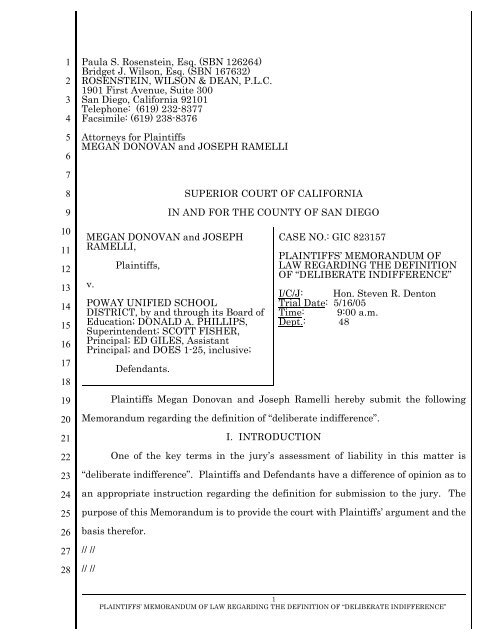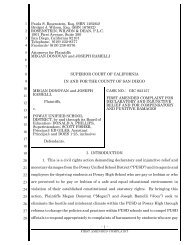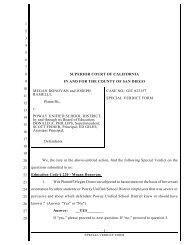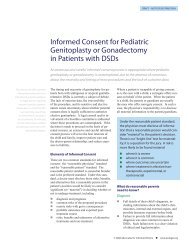Memorandum of Law Regarding the Definition of âDeliberate ...
Memorandum of Law Regarding the Definition of âDeliberate ...
Memorandum of Law Regarding the Definition of âDeliberate ...
Create successful ePaper yourself
Turn your PDF publications into a flip-book with our unique Google optimized e-Paper software.
1<br />
2<br />
3<br />
4<br />
5<br />
6<br />
Paula S. Rosenstein, Esq. (SBN 126264)<br />
Bridget J. Wilson, Esq. (SBN 167632)<br />
ROSENSTEIN, WILSON & DEAN, P.L.C.<br />
1901 First Avenue, Suite 300<br />
San Diego, California 92101<br />
Telephone: (619) 232-8377<br />
Facsimile: (619) 238-8376<br />
Attorneys for Plaintiffs<br />
MEGAN DONOVAN and JOSEPH RAMELLI<br />
7<br />
8<br />
9<br />
10<br />
11<br />
12<br />
13<br />
14<br />
15<br />
16<br />
17<br />
18<br />
19<br />
20<br />
21<br />
22<br />
23<br />
24<br />
25<br />
26<br />
27<br />
28<br />
MEGAN DONOVAN and JOSEPH<br />
RAMELLI,<br />
v.<br />
Plaintiffs,<br />
SUPERIOR COURT OF CALIFORNIA<br />
IN AND FOR THE COUNTY OF SAN DIEGO<br />
POWAY UNIFIED SCHOOL<br />
DISTRICT, by and through its Board <strong>of</strong><br />
Education; DONALD A. PHILLIPS,<br />
Superintendent; SCOTT FISHER,<br />
Principal; ED GILES, Assistant<br />
Principal; and DOES 1-25, inclusive;<br />
Defendants.<br />
CASE NO.: GIC 823157<br />
PLAINTIFFS’ MEMORANDUM OF<br />
LAW REGARDING THE DEFINITION<br />
OF “DELIBERATE INDIFFERENCE”<br />
I/C/J: Hon. Steven R. Denton<br />
Trial Date: 5/16/05<br />
Time: 9:00 a.m.<br />
Dept.: 48<br />
Plaintiffs Megan Donovan and Joseph Ramelli hereby submit <strong>the</strong> following<br />
<strong>Memorandum</strong> regarding <strong>the</strong> definition <strong>of</strong> “deliberate indifference”.<br />
I. INTRODUCTION<br />
One <strong>of</strong> <strong>the</strong> key terms in <strong>the</strong> jury’s assessment <strong>of</strong> liability in this matter is<br />
“deliberate indifference”. Plaintiffs and Defendants have a difference <strong>of</strong> opinion as to<br />
an appropriate instruction regarding <strong>the</strong> definition for submission to <strong>the</strong> jury. The<br />
purpose <strong>of</strong> this <strong>Memorandum</strong> is to provide <strong>the</strong> court with Plaintiffs’ argument and <strong>the</strong><br />
basis <strong>the</strong>refor.<br />
// //<br />
// //<br />
1<br />
PLAINTIFFS’ MEMORANDUM OF LAW REGARDING THE DEFINITION OF “DELIBERATE INDIFFERENCE”
1<br />
2<br />
3<br />
4<br />
5<br />
6<br />
7<br />
8<br />
9<br />
10<br />
11<br />
12<br />
13<br />
14<br />
15<br />
16<br />
17<br />
18<br />
19<br />
20<br />
21<br />
22<br />
23<br />
24<br />
25<br />
26<br />
27<br />
28<br />
II. “DELIBERATE INDIFFERENCE” - DEFINITION<br />
The definition <strong>of</strong> “deliberate indifference” as it relates to <strong>the</strong> Education Code<br />
violations should be a combination <strong>of</strong> <strong>the</strong> standard to which employers are held under<br />
<strong>the</strong> California Fair Employment and Housing Act and <strong>the</strong> discussion <strong>of</strong> “deliberate<br />
indifference” in <strong>the</strong> Ninth Circuit case <strong>of</strong> Flores v. Morgan Hill Unified School District<br />
(2003) 324 F 3d 1130.<br />
The FEHA standard should be taken into consideration as it is an antidiscrimination<br />
scheme crafted by <strong>the</strong> State Legislature based upon <strong>the</strong> priority <strong>of</strong><br />
eliminating discrimination and harassment from <strong>the</strong> workplace. The State Legislature<br />
has taken an equally strong viewpoint as to <strong>the</strong> elimination <strong>of</strong> discrimination and<br />
harassment in <strong>the</strong> educational environment, as demonstrated in Education Code § 200,<br />
et seq. Flores applies <strong>the</strong> “deliberate indifference” standard to a fact situation which is<br />
very similar to that which we have here and <strong>the</strong>refore <strong>the</strong> court’s reasoning in that<br />
matter is instructive to all, including <strong>the</strong> jury.<br />
Under FEHA, an employer is responsible for harassment <strong>of</strong> which it knew or<br />
should have known if it fails to take immediate and appropriate corrective action.<br />
Government Code § 12940(j)(1). Defendants would have <strong>the</strong> court use a “clearly<br />
unreasonable” standard instead. Fur<strong>the</strong>r, Defendants would raise <strong>the</strong> bar even more<br />
by saying that “a response by <strong>the</strong> Defendant that is merely inept, erroneous, ineffective<br />
or negligent does not amount to deliberate indifference”. (Defense Special Instruction<br />
No. 4: Deliberate Indifference) Defendants take this language from Federal pattern jury<br />
instructions and modify it using language from Davis v. Monroe County Board <strong>of</strong><br />
Education (1999) 527 US 629 and Gebser v. Lago Vista Independent School District<br />
(1998) 524 US 274.<br />
Plaintiffs contend that borrowing from <strong>the</strong>se two cases, which clearly analyzed<br />
Title IX in a restrictive manner which would raise <strong>the</strong> bar very high for Plaintiffs to<br />
succeed in a discrimination or harassment lawsuit, is <strong>the</strong> incorrect standard. Ra<strong>the</strong>r,<br />
“where <strong>the</strong> distinctive language <strong>of</strong> <strong>the</strong> FEHA evidences a legislative intent different<br />
2<br />
PLAINTIFFS’ MEMORANDUM OF LAW REGARDING THE DEFINITION OF “DELIBERATE INDIFFERENCE”
1<br />
2<br />
3<br />
from that <strong>of</strong> Congress” or where Title VII case law “appears unsound or conflicts with<br />
<strong>the</strong> purposes <strong>of</strong> FEHA”, California courts should decline to follow federal decisions. Page<br />
th<br />
v. Superior Court (1995) 31 Cal App 4 1206, 1215-1216; Fisher v. San Pedro Peninsula<br />
4<br />
Hospital (1989) 214 Cal App 3d 590, 606.<br />
The application <strong>of</strong> <strong>the</strong> “deliberate<br />
5<br />
6<br />
7<br />
8<br />
9<br />
10<br />
11<br />
12<br />
13<br />
14<br />
15<br />
16<br />
17<br />
18<br />
19<br />
20<br />
21<br />
22<br />
23<br />
24<br />
25<br />
26<br />
27<br />
28<br />
indifference” standard under <strong>the</strong> Education Code is an appropriate place to depart from<br />
<strong>the</strong> federal court interpretation <strong>of</strong> Title IX.<br />
A. Federal v. State Language:<br />
Title IX states, in part: “No person in <strong>the</strong> United States shall, on <strong>the</strong> basis <strong>of</strong> sex,<br />
be subjected to discrimination ...” While this language is strong, <strong>the</strong> remainder <strong>of</strong> <strong>the</strong><br />
section goes on to identify who is excluded. 20 U.S.C. § 1681.<br />
The California Education Code, on <strong>the</strong> o<strong>the</strong>r hand, places an “affirmative<br />
obligation to combat ... sexism, and o<strong>the</strong>r forms <strong>of</strong> bias ...” on California’s public schools.<br />
(Education Code § 201(b)) This language evidences an intention to go much fur<strong>the</strong>r than<br />
Title IX.<br />
B. Immediate and Appropriate Corrective Action:<br />
Using <strong>the</strong> FEHA standard <strong>of</strong> failing to take immediate and appropriate corrective<br />
action is appropriate under <strong>the</strong> Education Code. In California, it is apparent that <strong>the</strong><br />
state Legislature and <strong>the</strong> courts have attempted to keep <strong>the</strong> bar at a reasonable level<br />
so as to fur<strong>the</strong>r <strong>the</strong> public policy <strong>of</strong> eliminating discrimination and harassment in<br />
employment and educational situations. As such, <strong>the</strong> appropriate instruction to <strong>the</strong> jury<br />
should be <strong>the</strong> following:<br />
“Deliberate indifference” is found if <strong>the</strong> school administrator<br />
failed to take immediate and appropriate corrective action<br />
in response to harassment it knew or should have know about.<br />
For instance, failure to take reasonable steps to investigate<br />
and stop <strong>the</strong> harassment would support a finding <strong>of</strong> deliberate<br />
indifference, as does <strong>the</strong> failure to take fur<strong>the</strong>r steps once he<br />
knew his remedial measures were inadequate. Ano<strong>the</strong>r example<br />
would be failure to do anything reasonable about <strong>the</strong> ongoing<br />
harassment supports an inference <strong>of</strong> deliberate indifference.”<br />
Government Code § 12940(j)(1); Flores, supra.<br />
The proposed jury instruction is attached hereto as Exhibit “A”.<br />
3<br />
PLAINTIFFS’ MEMORANDUM OF LAW REGARDING THE DEFINITION OF “DELIBERATE INDIFFERENCE”
1<br />
2<br />
3<br />
4<br />
5<br />
6<br />
7<br />
8<br />
9<br />
10<br />
11<br />
12<br />
13<br />
14<br />
15<br />
16<br />
17<br />
18<br />
19<br />
20<br />
21<br />
22<br />
23<br />
24<br />
25<br />
26<br />
27<br />
28<br />
The examples contained in <strong>the</strong> last two sentences <strong>of</strong> <strong>the</strong> instruction are taken<br />
from Flores, supra and provide guidance to <strong>the</strong> jury as to what type <strong>of</strong> actions would be<br />
insufficient under <strong>the</strong> standard. While Defendants may not like <strong>the</strong>se examples, <strong>the</strong>y<br />
are actually a higher bar as <strong>the</strong>y are based upon <strong>the</strong> Title IX standard <strong>of</strong> “clearly<br />
unreasonable in light <strong>of</strong> <strong>the</strong> known circumstances” stated in Flores. None<strong>the</strong>less, <strong>the</strong>y<br />
can provide helpful guidance to <strong>the</strong> jury and it is <strong>the</strong> case most closely on point to <strong>the</strong><br />
instant situation.<br />
III. DEFENDANTS’ DEFINITION IS CONTRARY TO CALIFORNIA LAW.<br />
Defendants’ definition fails in two respects. A copy <strong>of</strong> Defendants’ instruction is<br />
attached as Exhibit “B”. Defendants’ instruction is erroneous in that it relies on Davis<br />
and Gebser to say that <strong>the</strong> Defendants’ response if it is inept, erroneous, ineffective or<br />
negligent is insufficient for a finding <strong>of</strong> liability. This would frustrate <strong>the</strong> California<br />
State Legislature’s goal <strong>of</strong> eliminating harassment if a Defendant could try anything at<br />
all and, even if it were ineffective or ludicrous, it would still satisfy <strong>the</strong> standard. It is<br />
clear that California wishes to take a harder line against discrimination and<br />
harassment and that is why <strong>the</strong> law has developed that <strong>the</strong> action to be taken by <strong>the</strong><br />
party in control must be both immediate and appropriate corrective action. Defendants’<br />
proposed standard is in keeping with <strong>the</strong> high bar set by <strong>the</strong> U.S. Supreme Court on<br />
Title IX actions, but it is contrary to <strong>the</strong> goals <strong>of</strong> California’s public policy.<br />
Defendants’ instruction is also inappropriate as Defendants have not argued that<br />
<strong>the</strong> students who were harassing Plaintiffs were not in <strong>the</strong> school district’s control or<br />
that <strong>the</strong>y did not have disciplinary authority over <strong>the</strong> person. Therefore, adding <strong>the</strong><br />
second paragraph, as Defendants wish to do, would only serve to confuse <strong>the</strong> jury and<br />
cause <strong>the</strong>m to have to consider an issue which is truly not before <strong>the</strong>m.<br />
// //<br />
// //<br />
// //<br />
IV. CONCLUSION<br />
4<br />
PLAINTIFFS’ MEMORANDUM OF LAW REGARDING THE DEFINITION OF “DELIBERATE INDIFFERENCE”
1<br />
2<br />
3<br />
Based upon <strong>the</strong> foregoing, it is clear that <strong>the</strong> jury instruction attached by<br />
Plaintiffs as Exhibit “A” is <strong>the</strong> appropriate definition <strong>of</strong> “deliberate indifference” and<br />
that which should be provided to <strong>the</strong> jury for its deliberations.<br />
4<br />
5<br />
6<br />
Dated: _________, 2005.<br />
Respectfully submitted,<br />
ROSENSTEIN, WILSON & DEAN, P.L.C.<br />
7<br />
8<br />
9<br />
10<br />
11<br />
12<br />
13<br />
14<br />
15<br />
16<br />
17<br />
18<br />
19<br />
20<br />
21<br />
22<br />
23<br />
24<br />
25<br />
26<br />
27<br />
28<br />
By:<br />
___________________________________________<br />
Paula S. Rosenstein, Esq.<br />
Bridget J. Wilson, Esq.<br />
Attorneys for Plaintiffs<br />
Joseph Ramelli and Megan Donovan<br />
5<br />
PLAINTIFFS’ MEMORANDUM OF LAW REGARDING THE DEFINITION OF “DELIBERATE INDIFFERENCE”





